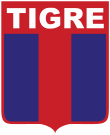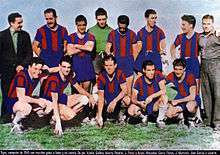Club Atlético Tigre
 | ||||
| Full name | Club Atletico Tigre | |||
|---|---|---|---|---|
| Nickname(s) | Matadores | |||
| Founded | 3 August 1902[1] | |||
| Ground | Coliseo de Victoria, Victoria, Buenos Aires | |||
| Capacity | 26,282[1] | |||
| Chairman | Rodrigo Molinos | |||
| Manager | Pedro Troglio | |||
| League | Primera División | |||
| 2016 | 9° of Zona 2 | |||
| Website | Club home page | |||
|
| ||||
Club Atlético Tigre (Spanish pronunciation: [ˈkluβ aˈtletiko ˈtiɣɾe]) is an Argentine sports club from Victoria, Buenos Aires. The club is mostly known for its football team, which currently plays in Argentine Primera División.
History
The club was founded on 3 August 1902 in the city of Tigre.[2] The team debuted at Argentine Primera División in 1915, playing its first match against Argentino de Quilmes, losing by 3–1. Tigre finally finished 18th of 25 teams.
Tigre would last in Primera División during all the amateur era. When football became professional in Argentina many teams were relegated but Tigre remained in the top division. The squad's first professional match was on 31 May 1931, playing against San Lorenzo de Almagro in the Viejo Gasómetro stadium. The first win came in the 3rd fixture when Tigre defeated Racing Club by 1–0.

The 14th fixture (played on August, 30) was the debut of legendary striker Bernabé Ferreyra, which scored all the goals in the 4–1 victory over Quilmes. Ferreyra soon became an outstanding scorer playing for Tigre (before being traded to River Plate).
In 1935 Tigre began to build its stadium in Victoria and that same year the team was relegated to the second division (then named "Segunda de Ascenso") along with Quilmes, returning the next year to the first division. That year Tigre also opened its stadium in Victoria.
In 1937 Juan Marvezzi (Tigre's all-time top scorer) arrived to the club. He would score 116 goals over 173 matches between 1937 and 1943.
In 1945 Tigre won the second division championship (Segunda Division).They won the tournament again in 1953, although by then it was known as Primera B.[3]

After some seasons alternating promotions and relegations to the second division, in 1970 Tigre was relegated to Primera C Metropolitana, the third division of the Argentine football league system, returning to Primera B two years after, with a record of 21 matches without receiving any goal. Goalkeeper Pepe achieved a record of 906 minutes unbeaten.
In 1979 Tigre returned to Primera División, with Juan Carlos Lorenzo as the sports director.
In 1986 the Argentine league system is restructured and Tigre got a place in the Primera B Nacional which became the second division of Argentine football. Five years later Tigre was relegated to Primera B Metropolitana (now the third division), returning to Nacional B in 1995 defeating Argentino de Rosario 2–1 in the third match (after two tied games).
Tigre won the 2004 Primera B Metropolitana Apertura defeating Platense 2–0 in Vicente López Partido. During that season, a goalkeeper (Cristian Campestrini) scored a goal for Tigre for the first time in club's history, during a match against Ferro Carril Oeste.
Tigre also won the next tournament (2005 Clausura) proclaiming bi-champion and promoting directly to Primera B Nacional.
At the end of 2006 Diego Cagna was hired as coach replacing Caruso Lombardi (who had left to coach Argentinos Juniors, recommended by Diego Maradona), being his first experience as coach in first division. With Cagna on the bench, Tigre remained 13 consecutive matches unbeaten during the Clausura tournament. In the 2005 Apertura the team finished 3rd. In the 2007 Clausura Tigre qualified to play the "Torneo Reducido", which won, giving it the chance to play with a team of Primera División (Nueva Chicago) in order to dispute a vacant place at the top level of Argentine football.
Tigre defeated Nueva Chicago 1–0 and 2–1, returning to Primera after 27 years. Some of its most relevant players were goalkeeper Daniel Islas, Alexis Ferrero, Diego Castaño and Leandro Lázzaro. During the second final game, hundreds of Chicago's hooligans jumped into the field without being stopped by the police (although there were 200 police man in the stadium), taking off the uniforms to players and then attacking Tigre's supporters which were peacefully celebrating their return to Primera División. The violent acts continued outside the stadium, where the hooligans of both teams clashed and a fan of Tigre, Marcelo Cejas, was killed.
Tigre disputed the 2007 Apertura achieving some resounding results such as the 4–1 victory over River Plate apart from the wins over Racing (3–2) and Boca Juniors (2–1). At the end of the tournament, Tigre finished 2nd (Lanús was the champion), which was club's best campaign ever in the top category.
In 2008 Apertura Tigre made the best campaign of its history, sharing the 1st place with Boca Juniors and San Lorenzo with 39 points at the end of the season. Therefore, those teams had to play a mini-tournament in order to proclaim a champion, which would finally be Boca Juniors. Although Tigre defeated Boca 1–0, the Xeneize won the title due to its best goal average. During the regular season, Tigre achieved some highlights, beating all the most popular teams: Boca Juniors (3–2), River Plate (3–1), Independiente (1–0), San Lorenzo (1–0), Huracán (3–0), and former champion Lanús (3–0).
In 2009 Tigre made its first appearances in an international club competition playing two games in Copa Sudamericana 2009, having been defeated by San Lorenzo in the first round due to the away goals rule.
In 2012 Tigre reached the final of the 2012 Copa Sudamericana, and faced São Paulo. The match, however, went unfinished, due to Tigre (who were at a 0–2 deficit by the end of the first half in the second leg) refusing to return for the second half as they claimed of security problems at halftime. Therefore, São Paulo were declared champions.[4]
Kit evolution and rare models
The first jersey worn by Tigre was blue with white collar.
Between 1911 and 1919, Tigre began to wear a red and blue vertical stripes jersey (similar to San Lorenzo's and used in seen in the pictures of the 1945 and 1953 champion teams). Tigre would wear this pattern in 1945, when winning the Primera B title promoting to Primera División.
Other models were a blue jersey with a red "T" on the chest (worn during Tigre's run on Primera División in 1980), and the blue with red sleeves (used for just one match in 1979).[5]
1902–11, 1919–40 |
1911–19, 1945 |
1940–present |
1960s |
1967–68 |
1979 (1) |
1980 |
1996–97 |
2005–06 |
2013 Libertadores |
Stadium

Their home stadium is the Estadio José Dellagiovanna.[1]
Players
Current squad
Current squad of Club Atlético Tigre as of October 10, 2016
()
Sources: Official website and Argentine Soccer
|
|
Manager: Pedro Troglio
Out on loan
Note: Flags indicate national team as defined under FIFA eligibility rules. Players may hold more than one non-FIFA nationality.
|
Managers
-
 Osvaldo Sosa (1981)
Osvaldo Sosa (1981) -
 Victorio Cocco (1989)
Victorio Cocco (1989) -
 Hugo Tocalli (1990–91)
Hugo Tocalli (1990–91) -
 Ricardo Caruso Lombardi (1 July 2003–31 Dec 06)
Ricardo Caruso Lombardi (1 July 2003–31 Dec 06) -
 Diego Cagna (1 Jan 2006–14 Dec 09)
Diego Cagna (1 Jan 2006–14 Dec 09) -
 Ricardo Caruso Lombardi (1 Jan 2010–31 Dec 10)
Ricardo Caruso Lombardi (1 Jan 2010–31 Dec 10) -
 Rodolfo Arruabarrena (30 Dec 2010–21 Oct 12)
Rodolfo Arruabarrena (30 Dec 2010–21 Oct 12) -
 Néstor Gorosito (23 Oct 2012–30 June 13)
Néstor Gorosito (23 Oct 2012–30 June 13) -
 Diego Cagna (7 July 2013–10 Sept 13)
Diego Cagna (7 July 2013–10 Sept 13) -
 Fabián Alegre (10 Sept 2013–31 Dec 13)
Fabián Alegre (10 Sept 2013–31 Dec 13) -
 Gustavo Alfaro (2014–2015)
Gustavo Alfaro (2014–2015) -
 Mauro Camoranesi (2016)
Mauro Camoranesi (2016) -
 Pedro Troglio (2016)
Pedro Troglio (2016)
Honours
- Primera B (4): 1945, 1953, 1979, 2004–05
- División Intermedia (1): 1912 FAF,
- Trofeo Jaime Sarlanga (1): 1967
References
- 1 2 3 "CA Tigre". Soccerway. Global Sports Media. Retrieved 16 June 2013.
- ↑ "Historia del Club Atlético Tigre" (in Spanish). Club Atletico Tigre. Retrieved 16 June 2013.
- ↑ Mariano Buren (15 July 2011). "Argentina – Coaches of Championship Teams – Second Level". RSSSF. Retrieved 16 June 2013.
- ↑ "Copa Sudamericana: Row at Tigre and Sao Paulo final". BBC. 13 December 2012. Retrieved 16 June 2013.
- ↑ Historia de la Camiseta – Official website
External links
| Wikimedia Commons has media related to Club Atlético Tigre. |